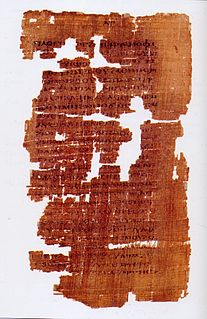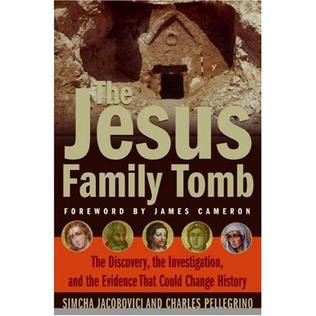
Gospel, meaning "Good News", originally meant the Christian message, but in the 2nd century it came to be used also for the books in which the message was set out; in this sense a gospel can be defined as a loose-knit, episodic narrative of the words and deeds of Jesus of Nazareth, culminating in his trial and death and concluding with various reports of his post-resurrection appearances.

Mary Magdalene, sometimes called Mary of Magdala, or simply the Magdalene or the Madeleine, was a woman who, according to the four canonical gospels, traveled with Jesus as one of his followers and was a witness to his crucifixion and resurrection. She is mentioned by name twelve times in the canonical gospels, more than most of the apostles and more than any other woman in the gospels, other than Jesus's family. Mary's epithet Magdalene may mean that she came from the town of Magdala, a fishing town on the western shore of the Sea of Galilee in Roman Judea.

The New Testament (NT) is the second division of the Christian biblical canon. It discusses the teachings and person of Jesus, as well as events in first-century Christianity. The New Testament's background, the first division of the Christian Bible, is called the Old Testament, which is based primarily upon the Hebrew Bible; together they are regarded as sacred scripture by Christians.

The Infancy Gospel of Thomas is a biographical gospel about the childhood of Jesus, believed to date at the latest to the second century. The Infancy Gospel of Thomas was thought to be Gnostic in origin because of references to a "Gospel of Thomas", but those works are not referencing this Infancy Gospel, as many scholars had thought, but rather to the wholly different Gospel of Thomas.

The Gospel of Philip is a non-canonical Gnostic Gospel dated to around the 3rd century but lost in medieval times until rediscovered by accident, buried with other texts near Nag Hammadi in Egypt, in 1945.
Injil is the Arabic name for the Gospel of Jesus (Isa). This Injil is described by the Qur'an as one of the four Islamic holy books which was revealed by God, the others being the Zabur, the Tawrat, and the Qur'an itself. The word Injil is also used in the Quran, the Hadith and early Muslim documents to refer to both a book and revelations made by Allah to prophet Isa.

The Greek Acts of Philip is an episodic gnostic apocryphal book of acts from the mid-to-late fourth century, originally in fifteen separate acta, that gives an accounting of the miraculous acts performed by the Apostle Philip, with overtones of the heroic romance.

Joseph and Aseneth is a narrative that dates from between 200 BCE and 200 CE. The first part of the story, an expansion of Genesis 41:45, describes the diffident relationship between Aseneth, the daughter of an Egyptian priest of Heliopolis and the Hebrew patriarch Joseph, the vision of Aseneth in which she is fed honeycomb by a heavenly being, her subsequent conversion to the God of Joseph, followed by romance, marriage, and the birth of Manasseh and Ephraim. The second part involves a plot by the Pharaoh's son, who recruits Dan and Gad to kill Joseph, only to be thwarted by Benjamin and Levi.
On the issue of the sexuality of Jesus, the traditional understanding of Christian churches and theologians is that Jesus did not marry and remained celibate until his death. That has not prevented speculation about alternative and fringe theories of his sexuality. The Gospels and the New Testament reveal little on the subject.
The Jesus bloodline refers to the proposition that a lineal sequence of descendants of the historical Jesus has persisted to the present time. The claims frequently depict Jesus as married, often to Mary Magdalene, and as having descendants living in Europe, especially France but also the UK. Differing and contradictory Jesus bloodline scenarios, as well as more limited claims that Jesus married and had children, have been proposed in numerous modern books. Some such claims have suggested that Jesus survived the crucifixion and went to another location such as France, India or Japan.

Simcha Jacobovici is an Israeli-Canadian film director, producer, freelance journalist, and New York Times bestselling author.
James D. Tabor is a Biblical scholar and Professor of Ancient Judaism and Early Christianity in the Department of Religious Studies at the University of North Carolina at Charlotte, where he has taught since 1989 and served as Chair from 2004–14. He previously held positions at Ambassador College, the University of Notre Dame (1979–85), and the College of William and Mary (1985–89). Tabor is the founder and director of the Original Bible Project, a non-profit organisation aimed to produce a re-ordered new translation of the Bible in English.
Lost Gospel may refer to:

The Lost Tomb of Jesus is a docudrama co-produced and first broadcast on the Discovery Channel and Vision TV in Canada on March 4, 2007, covering the discovery of the Talpiot Tomb. It was directed by Canadian documentary and film maker Simcha Jacobovici and produced by Felix Golubev and Ric Esther Bienstock, while James Cameron served as executive producer. The film was released in conjunction with a book about the same subject, The Jesus Family Tomb, issued in late February 2007 and co-authored by Jacobovici and Charles R. Pellegrino. The documentary and the book's claims have been rejected by the overwhelming majority of leading experts within the archaeological and theological fields, as well as among linguistic and biblical scholars.

The Jesus Family Tomb: The Discovery, the Investigation, and the Evidence That Could Change History (ISBN 0061192023) is a controversial book by Simcha Jacobovici and Charles R. Pellegrino published in February 2007. It tells the story of the discovery of the Talpiot Tomb on Friday March 28, 1980 and makes an argument that it is the tomb of Jesus Christ and his family.
Barrie A. Wilson is Professor Emeritus and Senior Scholar, Humanities and Religious Studies, York University, Toronto, where he has taught since 1974. An historian of religion, he specializes in movements in early Christianity. Throughout the 1990s he was Chair, Religious Studies, Atkinson College, York University. From 1969 to 1974 he taught Ancient Philosophy and Logic at Saint Louis University in St. Louis, Missouri.
Pseudo-Zacharias Rhetor is the designation used by modern scholarship for the anonymous 6th-century author who compiled a twelve-part history in the Syriac language around 569. It contains portions of the otherwise lost Ecclesiastical History of the real Zacharias Rhetor.

Infancy gospels are a genre of religious texts that arose in the 2nd century. They are part of New Testament apocrypha, and provide accounts of the birth and early life of Jesus. The texts are of various and uncertain origin, and are generally non-canonical in major modern branches of Christianity. They include the Gospel of James, which introduces the concept of the Perpetual Virginity of Mary, and the Infancy Gospel of Thomas, both of which cover many miraculous incidents from the life of Mary and the childhood of Jesus that are not included in the canonical gospels. Although the Life of John the Baptist focuses on John the Baptist rather than Jesus or his immediate family, it is also included in the genre as its events would be contemporary with Jesus's early life.
Moses of Ingila was a Syriac Christian author who translated a number of texts from Greek into the Syriac language.







